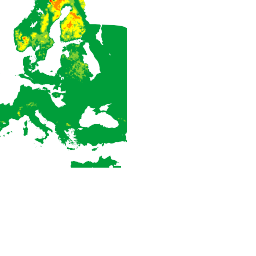Что такое универсальный пыльцевой индекс (UPI)?
Универсальный пыльцевой индекс (UPI) разработан для создания унифицированной глобальной шкалы для сравнения уровней пыльцы в различных регионах. Индекс помогает оценить риск воздействия пыльцы на основе различных факторов для людей с аллергией или повышенной чувствительностью к пыльце. Основанный на многослойной модели, он представляет собой представление данных об уровне пыльцы, учитывающее концентрацию пыльцы в каждой модели растения, множество различных локальных пыльцевых индексов (LPI), используемых по всему миру, и аллергенность различных видов пыльцы растений для прогнозирования количества пыльцевых зерен на кубический метр (зерен/м³) в день.
Конечная точка heatmapTiles возвращает фрагменты тепловой карты, которые можно наложить на базовую карту. На фрагментах тепловой карты отображается индекс UPI по всему миру для заданного типа растений ( TREE , GRASS или WEED ).
Индекс состоит из шести категорий:
| Ценить | Цвет | Описание |
|---|---|---|
| 0 | Никто | |
| 1 | Очень низкий | |
| 2 | Низкий | |
| 3 | Умеренный | |
| 4 | Высокий | |
| 5 | Очень высокий |
Каждая категория основана на конкретных уровнях концентрации пыльцы в определённом районе и их влиянии на тяжесть аллергических симптомов, что обеспечивает комплексное представление об уровнях пыльцы. Интеграция UPI позволяет пользователям сравнивать и оценивать ситуацию с пыльцой в различных местах.
Например, на следующей плитке тепловой карты показаны уровни пыльцы TREE в диапазоне от «Очень низкого» до «Очень высокого» :

Поддерживаемые растения
API Pollen поддерживает 3 различных типа растений: травы , сорняки и деревья . Поскольку доступность растений зависит от фактических измерений и отчётов источников данных, данные API Pollen по растениям могут различаться в зависимости от местоположения.
В следующем списке показаны поддерживаемые коды растений и их метаданные:
| Код завода | Отображаемое имя | Тип |
|---|---|---|
ALDER | Ольха | Дерево |
ASH | Пепел | Дерево |
BIRCH | Береза | Дерево |
COTTONWOOD | Коттонвуд | Дерево |
ELM | Вяз | Дерево |
MAPLE | Клен | Дерево |
OLIVE | Оливковый | Дерево |
JUNIPER | Можжевельник | Дерево |
OAK | Дуб | Дерево |
PINE | Сосна | Дерево |
CYPRESS_PINE | Кипарисовая сосна | Дерево |
HAZEL | Орех | Дерево |
GRAMINALES | Травы | Трава |
JAPANESE_CEDAR | японский кедр | Дерево |
JAPANESE_CYPRESS | японский кипарис | Дерево |
RAGWEED | Амброзия | Сорняк |
MUGWORT | Полынь | Сорняк |

